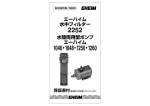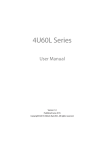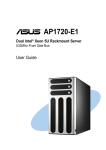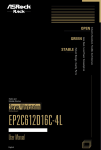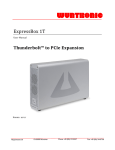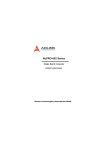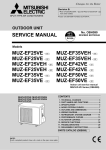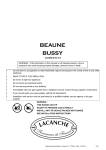Download Asrock 1U12LW-C2550 server barebone
Transcript
Version 1.0 Published December 2013 Copyright©2013 ASRockRack Inc. All rights reserved. Copyright Notice: No part of this documentation may be reproduced, transcribed, transmitted, or translated in any language, in any form or by any means, except duplication of documentation by the purchaser for backup purpose, without written consent of ASRockRack Inc. Products and corporate names appearing in this documentation may or may not be registered trademarks or copyrights of their respective companies, and are used only for identiication or explanation and to the owners’ beneit, without intent to infringe. Disclaimer: Speciications and information contained in this documentation are furnished for informational use only and subject to change without notice, and should not be constructed as a commitment by ASRockRack. ASRockRack assumes no responsibility for any errors or omissions that may appear in this documentation. With respect to the contents of this documentation, ASRockRack does not provide warranty of any kind, either expressed or implied, including but not limited to the implied warranties or conditions of merchantability or itness for a particular purpose. In no event shall ASRockRack, its directors, oicers, employees, or agents be liable for any indirect, special, incidental, or consequential damages (including damages for loss of proits, loss of business, loss of data, interruption of business and the like), even if ASRockRack has been advised of the possibility of such damages arising from any defect or error in the documentation or product. his device complies with Part 15 of the FCC Rules. Operation is subject to the following two conditions: (1) this device may not cause harmful interference, and (2) this device must accept any interference received, including interference that may cause undesired operation. CALIFORNIA, USA ONLY he Lithium battery adopted on this motherboard contains Perchlorate, a toxic substance controlled in Perchlorate Best Management Practices (BMP) regulations passed by the California Legislature. When you discard the Lithium battery in California, USA, please follow the related regulations in advance. “Perchlorate Material-special handling may apply, see www.dtsc.ca.gov/hazardouswaste/ perchlorate” ASRockRack’s Website: www.ASRockRack.com Setting up the Server in a Restricted Access Location • Access can only be gained by service persons or by users who have been instructed about the reasons for the restrictions applied to the location and about any precautions that shall be taken. • Access is through the use of a tool or lock and key, or other means of security, and is controlled by the authority responsible for the location. • Leave enough clearance (25 inches in the front and 30 inches in the back of the rack) to allow the front door to be opened completely and to allow for suicient airlow. • his product is for installation merely in a Restricted Access Location. • his product is not suitable for use with visual display work place devices according to §2 of the the German Ordinance for Work with Visual Display Units. Replaceable Batteries CAUTION RISK OF EXPLOSION IF BATTERY IS REPLACED BY AN INCORRECT TYPE. DISPOSE OF USED BATTERIES ACCORDING TO THE INSTRUCTIONS Important Safety Instructions Pay close attention to the following safety instructions before performing any of the operation. Basic safety precautions should be followed to protect yourself from harm and the product from damage: • Operation of the product should be carried out by suitably trained, qualiied, and certiied personnel only to avoid risk of injury from electrical shock or energy hazard. • Disconnect the power cord from the wall outlet when installing or removing main system components, such as the motherboard and power supply unit. • Place the system on a stable and lat surface. • Use extreme caution when working with high-voltage components. • When handling parts, use a grounded wrist strap designed to prevent static discharge. • Keep the area around the system clean and clutter-free. • Keep all components and printed circuit boards (PCBs) in their antistatic bags when not in use. • Handle a board by its edges only; do not touch its components, peripheral chips, memory modules or contacts. Contact Information If you need to contact ASRockRack or want to know more about ASRockRack, you’re welcome to visit ASRockRack’s website at www.ASRockRack.com; or you may contact your dealer for further information. ASRockRack Incorporation 6F., No.37, Sec. 2, Jhongyang S. Rd., Beitou District, Taipei City 112, Taiwan (R.O.C.) Contents Chapter 1 Introduction 1 1.1 Shipping Box Contents 1 1.2 Speciications 2 Chapter 2 Server System Overview 3 2.1 System Components 3 2.2 Cable Connections 4 2.3 System Front Panel 6 2.4 System Rear Panel 6 2.5 Front Control Panel Buttons and LEDs 7 Chapter 3 Hardware Installation and Maintenance 9 3.1 Server Top Cover 10 3.2 Hard Drive 12 3.3 Power Supply 17 3.4 Add-on Card 18 3.5 System Fan 19 3.6 Backplane 20 3.7 Server Board 21 3.8 Chassis Cables 22 Chapter 4 Backplane Speciications 26 Appendix A Installing the Server in a Rack 30 Chapter 1 Introduction hank you for purchasing 1U12L Series, a reliable barebone system produced under ASRockRack’s consistently stringent quality control. It delivers excellent performance with robust design conforming to ASRockRack’s commitment to quality and endurance. Because the hardware speciications might be updated, the content of this documentation will be subject to change without notice. In case any modiications of this documentation occur, the updated version will be available on ASRockRack’s website without further notice. If you require technical support related to this product, please visit our website for speciic information about the model you are using. ASRockRack’s Website: www.ASRockRack.com he illustrations shown in this manual are examples only, the actual system may difer slightly . 1.1 Shipping Box Contents • • • • • • • • 1U12L Series Barebone (1U form factor) System Board Power Supply Unit (pre-installed) System Fans x 5 (pre-installed) HDD Backplanes x 3 (pre-installed) Front Panel Board x1 (pre-installed) Chassis Cables* Screws x 74 • User Manual • Quick Installation Guide * Type and quantity may vary depending on the server board that comes with your system. If any items are missing or appear damaged, contact your authorized dealer. English 1 1.2 Speciications 1U12L Series System Physical Status Form Factor 1U Rackmount Dimension 31.9" x 16.9" x 1.7" (810 X 430 X 43.5 mm) (D x W x H) Support MB Size Extend Mini ITX Front Panel Buttons LEDs I/O Ports Drive Bay Internal System Cooling Fan Power Supply Capacity Output Watts • Power On/Standby button • UID button* • System reset button • NMI button* • Power LED • Identiication LED* • Hard drive activity LED* • 2x Network activity LEDs* 2 x USB 2.0 ports • 12 x 3.5" SATA HDDs (6Gb/s) • 2 x 2.5" SATA HDDs (6Gb/s)* 6 x 40*56mm system fans 1U, Single 250 W Bronze/ 450 W Gold* *Please be noted that the functions are supported depending on the type of the server board. English 2 Chapter 2 Server System Overview his chapter provides diagrams showing the location of important components of the server system. 2.1 System Components Top Cover Power Supply Unit 5 x System Fans 12 x 3.5” HDD Carriers 2 x 2.5” HDD Carriers Server Board Front Controls and Indicators English 3 2.2 Cable Connections 1 3 4 2 5 7 6 8 9 10 11 12 13 14 18 19 23 24 15 16 17 20 21 22 English 25 4 No. From To Cable* 1 2.5" HDD 1 SB / PSU Power supply cable 2 2.5" HDD 2 SB / PSU Power supply cable 3 Server Board (SB) 4 Power Supply Unit (PSU) SB / BP1~3 Power supply cables 5 System Fan 5 SB Fan cable 6 System Fan 4 SB Fan cable 7 System Fan 3 SB Fan cable 8 System Fan 2 SB Fan cable 9 System Fan 1 SB Fan cable 10 HDD Backplane 1 (BP1) SB PSU MiniSAS to SATA cable 1 Power supply cables 11 3.5" HDD 0 BP1 N/A 12 3.5" HDD 1 BP1 N/A 13 3.5" HDD 2 BP1 N/A 14 3.5" HDD 3 BP1 N/A 15 HDD Backplane 2 (BP2) SB PSU MiniSAS to SATA cable 2 Power supply cables 16 3.5" HDD 4 BP2 N/A 17 3.5" HDD 5 BP2 N/A 18 3.5" HDD 6 BP2 N/A 19 3.5" HDD 7 BP2 N/A 20 HDD Backplane 3 (BP3) SB PSU MiniSAS to SATA cable 3 Power supply cables 21 3.5" HDD 8 BP3 N/A 22 3.5" HDD 9 BP3 N/A 23 3.5" HDD 10 BP3 N/A 24 3.5" HDD 11 BP3 N/A SB Front panel cable USB cable 25 Front Panel Board (FPB) *Only supplied cables are mentioned in this table. English Conenctions and cable routing may difer depending on various server boards. Please refer to the Quick Installation Guide to know the exact headers or cables to be connected on the server board you purchase. For more detailed information about server board components, refer to the manual that comes with your server board. 5 2.3 System Front Panel 1 No. 1 2 2 Description 2 x USB 2.0 Ports Control Panel Buttons and LEDs 2.4 System Rear Panel 1 No. 1 2 3 4 English 6 2 3 4 Description Power Supply Unit I/O Shield (depends on the speciication of the server board) Rear Vent 1 x PCI Express Slot (for the riser card) 2.5 Front Control Panel Buttons and LEDs Front Control Panel No. 1 2 3 4 5 6 1 2 NMI RST 4 3 L1 L2 5 6 UID Description NMI (Nonmaskable Interrupt) Button* System Reset Button LAN1, LAN2 Activity LED* HDD Status LED* UID Button and LED* Power Button and LED *Please be noted that the functions are supported depending on the type of the server board. NMI (Nonmaskable Interrupt) Button Press the NMI button with a paper clip or pin to generate a nonmaskable interrupt and to put the server in a halt state for examination. System Reset Button When the system is completely unresponsive, press the system reset button to reboot the server without shutting it of and initialize the system. UID Button Press the UID button to toggle the front panel UID LED and the baseboard UID LED on and of. You are able to locate the server you’re working on from behind a rack of servers. Power Button Press the power switch button to toggle the system power on and standby/sleep modes. To remove all power from the system completely, disconnect the power cord from the server. English 7 Status LED Deinitions Power LED Status Description Green Blinking Green Of Power on Standby(Sleep) mode Power of UID LED Status Description Blue Of System identiication is active. System identiication is disabled. HDD Status LED Status Description Green Of HDD access HDD idle LAN1, LAN2 LED English 8 Status Description Green Blinking Green Link between system and network or no access Network access Chapter 3 Hardware Installation and Maintenance his chapter helps you assemble the chassis and install components. Before You Begin Before you work with the server, pay close attention to the “Important Safety Instructions” at the beginning of this manual. 1. Make sure the server is powered of. Power down the server if it is still running. (1) Press the Power button to power of the server from full-power mode to standbypower (sleep) mode. he Power LED at the front turns from solid green to blinking green. (2) Disconnect the power cord irst from the AC outlet and then from the server. he power LED turns of. he server is not completely powered down when you press the Power button on the front panel. he Power button lets the server toggle between Power On and Standby (Sleep) modes. Some internal circuitry remain active in the Standby mode. To remove all power from the system completely, be sure to disconnect the power cord from the server. 2. Ensure you have a clean and stable working environment. Avoid dust and dirt because contaminants may cause malfunctions. 3. Ground yourself properly before touching any system component. A discharge of static electricity may damage components. Wear a grounded wrist strap if available. Installing Procedures he followings are prerequisite to be installed. 3.5" or 2.5" HDD(s) • Power Supply (Pre-installed) • Server Board (Pre-installed) • Fans (Pre-installed) • HDD Backplanes (Pre-installed) • English An add-on card is optional to be installed when you have a riser board intalled on your server board. 1. Some components are already pre-installed. Simply properly connect the relavant cables before or ater installation. See the Quick Installation Guide for more details. 2. Refer to the user manual of the server board you use for instructions on how to install server board components. 9 3.1 Server Top Cover Removing the Server Top Cover 1. Before removing the top cover, power of the server and unplug the power cord. 2. he system must be operated with the chassis top cover installed to ensure proper cooling. 1 1 1 3 1 1 1 2 English 1. Remove the six screws that secure the top cover to the chassis. 2. Push the top cover toward the rear of the chassis to remove the cover from the locked position. 3. Lit up and remove the top cover. 10 Installing the Server Top Cover 3 3 3 1 3 3 3 2 1. Lower the top cover on the chassis, making sure the side latches align with the cutouts. 2. Slide the top cover toward the front. 3. Secure the top cover with the six screws. English 11 3.2 Hard Drive 3.2.1 Installing a Hard Disk Drive into 3.5" Hard Drive Carrier his system allows the routing of cables behind the HDD base plate and carriers. Be sure to connect all required cables irst before installing any of the 3.5” HDDs. Meanwhile, please well organize your cables and be careful with your cable routing. You can refer to the Quick Installation Guide for more information. Removing a 3.5” Hard Drive Carrier from the Chassis 1. Release the thumb screw that secures the hard drive carrier to the base plate. 2. Lit up and remove the carrier from the base plate. 2 3.5” HDD Carrier 1 Base Plate English 12 Installing a 3.5” Hard Drive to the Hard Drive Carrier 1. Place the 3.5" HDD into the carrier with the printed circuit board side facing down. Carefully align the mounting holes in the hard drive and the carrier. 2. Secure the hard drive using the four screws. 3. Place the hard drive carrier on the base plate with the thumb screw facing the front of the chassis. 4. Align the keyhole openings on the base with the locating pins on the bottom of the hard drive carrier. Pull the hard drive carrier toward the rear of the chassis until the carrier clips. 5. Tighten the thumb screw on the carrier to secure the hard drive carrier to the base plate. 1 2 4 5 3 English 13 Removing a Hard Disk Drive Base Plate from the Chassis Organize your cables and place them under the hard drive base plates before installing 3.5" HDDs. 1. Remove the screws that secure the hard drive base plate. 1 1 1 English 14 1 3.2.2 Installing a Hard Disk Drive into 2.5" Hard Drive Carrier Removing 2.5” Hard Drive Carriers from the Chassis 1. Remove the screws that secure the 2.5" hard drive carrier. 1 1 English 15 Installing a 2.5” Hard Drive to the Hard Drive Carrier 1. Place a 2.5" HDD into the carrier with the label facing up and the connector end toward the server board. Carefully align the mounting holes in the hard drive and the carrier. 2. Secure the hard drive using the four screws. 3. Place the drive carrier back to the chassis with screw holes aligned. Secure each drive carrier with the two screw. 1 2 3 5 3 English 16 3.3 Power Supply Installing and Removing the Power Supply 1. 2. 3. Place the power supply unit in the chassis with the fan facing right. Align the mounting screw holes and secure the power supply unit with the six screws. Reverse the procedure to remove the power supply. 1 2 2 2 2 English Before replacing the power supply, power of the server, unplug the power cord, and disconnect all wiring from the power supply. 17 3.4 Add-on Card 1. You can install an add-on card to the chassis only when you have a riser card installed on the server board. 2. Before installing the add-on card, power of the server and unplug the power cord. Removing the Blanking Plate from the Chassis 1. Remove the screw securing the blanking plate on the chassis. Keep this screw for later use. 2. Push the the right end of the blanking plate toward the chassis. 3. Slide the blanking plate out sideways. 3 1 2 4. Reverse the procedure to install the add-on card in the chassis. English 18 3.5 System Fan Replacing the System Fan 1. Unplug the fan connecter and remove the failed fan. 2. Align the mounting holes on the fan bar with the fan mounts on the replacement fan corners. 3. Gently place the fan on the fan bar. Make sure the fan is well seated. 4. Connect the end of the fan cable to the fan connector. Fan Mount Mounting Hole English 19 3.6 Backplane Each barebone system supports three 3.5-inch HDD backplanes. he miniSAS/ SATA backplanes serve as the interfaces between the server board and the HDDs. Before removing and installing the backplanes, power of the server and unplug the power cord and make sure all 3.5” HDDs have been removed. For the speciication of the backplane, please refer to the Chapter 4. Removing the Backplanes 1. Remove all of cables connected to the backplanes. 2. Loosen the securing screws on the backplanes. 3. Lit the backplanes up from the chassis. Hold the backplanes only by the edges. English 20 3.7 Server Board Follow the steps below to install the server board to the chassis. 1. Hold the server board only by the edges. 2. Gently place the server board into the chassis. Sit the server board on the server board tray. 3. Position the server board in the server system. Align mounting holes of the server board to the standof on the chassis. 4. Aix the screws clockwise into the mounting holes in all of the corners of the server board. 1. Do not over-tighten the screws! Doing so may damage the server board. 2. Refer to the user manual of the server board you use for instructions on how to install and remove the server board components and how to use its setup utility. English 21 3.8 Chassis Cables his section lists supported cables for your chassis system. Cable type and quantity vary depending on the server board that comes with your system. 1. MiniSAS to SATA Cable 1 (400mm) (Quantity: 1) BP1 Server Board Port 0-3 2. MiniSAS to SATA Cable 2 (550mm) (Quantity: 1) BP2 English 22 Server Board Port 4-7 3. MiniSAS to SATA Cable 3 (600mm) (Quantity: 1) BP3 4. Server Board Port 8-11 MiniSAS to MiniSAS Cable 1 (120mm) (Quantity: 1) BP1 5. Server Board MiniSAS to MiniSAS Cable 2 (300mm) (Quantity: 1) BP2 6. MiniSAS to MiniSAS Cable 3 (480mm) (Quantity: 1) English BP3 23 Server Board Server Board 7. SATA Cable 1 (350mm) (Quantity: 1) SATA HDD 8. Server Board SATA Cable 1 (500mm) (Quantity: 1) SATA HDD 9. Server Board SMBus Cable (150/150/300mm) (Quantity: 1) BP1 CQC ! BP2 NC Server Board BP3 10. Front Panel Cable (1000mm) (Quantity: 1)* PANEL1 FPB AUX_PANEL1 English NMI_BTN Server Board *he NMI function is not supported for the 1U12L Series. 24 11. Fan Cable (70mm) (Quantity: 1) Server Board 12. Fan USB Cable (1000mm) (Quantity: 1) Server Board FPB 1. Remove all 3.5” HDDs carriers when you are going to connect various components with cables. 2. Conenctions and cable routing may difer depending on various server boards. Please refer to the Quick Installation Guide to know the exact headers or connectors to be connected on the server board you purchase. For more detailed information about server board components, refer to the manual that comes with your server board. English 25 Chapter 4 Backplane Speciications Hard Drive Backplanes (BP) ( to connect 4x3 3.5" HDDs) 1U12LIW-BPB1 / 1U12LIW-BPB2 / 1U12LIW-BPB3 Top View 1 2 7 English 26 3 4 8 No. Description 1 2 3 4 5 6 7 8 9 10 I2C Address Settings (J2) SGPIO Code Programming Pin BMC SMBus Connector (BMC_SMB) Mini-SAS Connector DC Power Connector (DC-IN 1) DC Power Connector (DC-IN 2) SATA Hot-swap Connector 1 SATA Hot-swap Connector 2 SATA Hot-swap Connector 3 SATA Hot-swap Connector 4 5 9 6 10 Front Panel Board (FPB) 1U12LIW-FPB1 Top View 1 2 1 1 3 4 5 6 7 8 9 10 11 No. Description 1 2 3 4 5 6 7 8 9 10 11 USB Header (USB_Header) Front and Auxiliary Panel Header (Front + AUX Panel) Front USB 2.0 Connector (Front_USB_1) Front USB 2.0 Connector (Front_USB_2) NMI Button (CON2) System Reset Button (CON1) LAN 1 Activity LED* (LED2) LAN 2 Activity LED* (LED3) HDD Activity LED* (LED1) ID Button and LED* (U2) Power Button and LED (U3) *Please be noted that the functions are supported depending on the type of the server board. English 27 Jumper Setup he illustration shows how jumpers are setup. When the jumper cap is placed on the pins, the jumper is “Short”. If no jumper cap is placed on the pins, the jumper is “Open”. he illustration shows a 3-pin jumper whose pin1 and pin2 are “Short” when a jumper cap is placed on these 2 pins. I2C Address Setting Jumper for BP (7-pin J2) (see p.26, No. 1) 4 8 6 3 7 5 3-4: BP3 5-6: BP1 7-8: BP2 Pin Deinitions DC Power Connector (DC-IN1) (DC-IN2) (see p.26, No. 5, 6) he 4-pin connectors provide power to the backplane. +5V GND1 GND2 +12V Mini-SAS Connector (see p.26, No. 4) English 28 his connector is used to connect RAID card or the mini-SAS port on the motherboard. SMB Connector (5-pin BMC_SMB1) (5-pin BMC_SMB2) (5-pin BMC_SMB3) (see p.26, No. 3) he SMB (SubMiniature version B) connector provides a communication interface between the backplane and the motherboard. USB_PWR -B +B USB 2.0 Header (9-pin USB_HEADER) (see p.27, No. 1) he header supports two USB 2.0 ports on the front panel. GND DUMMY 1 English 29 LocatorLED- GND LAN1 LED- LAN2 LED- LocatorLED+ +3VSB PWR BTN NMI BTN PLED- UID BTN GND GND GND HDLED- RST BTN 1 HDLED+ Front and Auxiliary Panel Header (17-pin FRONT + AUX PANEL) (see p.27, No. 2) PLED+ GND +A -A USB_PWR his header supports multiple functions on the front panel. Appendix A Installing the Server in a Rack his section describes how to rackmount the 1U12L Series server with slide rail assemblies. he rails installation instructions in this manual are example only, your actual rail assembly procedure may difer slightly . he slide rail assembly consists of a chassis rail and a slide rail. You need to attach the chassis rails to the server and attach the slide rail assemblies to the rack. Slide Rail Chassis Rail 3 Removing the Chassis Rail from the Slide Rail Assembly 1. 2. 3. Pull out the inner chassis rail from the rail assembly. Push the white chassis rail release button toward the front, and simultaneously withdraw the chassis rail from the slide rail assembly. Repeat for the remaining rail assembly. 2 1 English 30 To slide a chassis rail back into the slide rail assembly, push the blue release button toward the rear, and simultaneously slide the chassis rail into the slide rail assembly until it is locked and cannot be pushed further. Attaching the Chassis Rails to the Server 1. 2. 3. 4. English 31 Position a chassis rail along one side of the chassis, and align the keyhole openings on the chassis rail with the locating pins on the side of the chassis. Pull the chassis rail toward the front of the chassis until the chassis rail clips. Make sure the rail is installed in the correct direction. Secure the chassis rail to the server chassis with screws. Repeat for the remaining chassis rail. Attaching the Slide Rail Assemblies to the Rack 1. 2. Determine where to attach the slide rails. Make sure you have three holes of free space above the slide rail bracket. For the rack with square mounting holes, insert cage nuts in the holes that you will use on the rack. 1 Free Space 12 U Cage Nuts 11U 3. Extend the pre-attached front and rear adjustable brackets on the slide. Do not fully tighten the nuts yet. Rear Bracket Front Bracket English 32 4. Adjust the brackets to accommodate the depth of the rack. 11U 11U 5. 6. Align the holes on the brackets with the mounting holes you selected on the rack. Tighten the screws to secure the slide rails to the rack. Make sure the rear bracket meets the rear vertical rail of the rack. 12 U 11U English 33 7. Fully tighten the lock nuts on the rear bracket. 12 U 11U Sliding the Server into the Rack 1. 2. Ensure that the slide rails are properly and securely attached to the rack. Fully extend the slide rails from the rack by pulling the inner rails out until they are locked and cannot be pulled out further. 12 U 11U English To slide an inner rail back into the slide rail, press the metal tab on the inner rail, and simultaneously slide the inner rail into the slide rail . 34 3. Slide the server slowly and evenly all the way into the cabinet to ensure that the slide assemblies are working correctly. he server is heavy. For safe liting, two or more persons are required to install the server into the rack. 12U 11U 4. 5. Secure the server to the rack with screws. To remove the server from the rack, reverse these instructions. English When connecting cables to the server, make sure there is enough cable slack so you can slide the server in and out of the rack without accidentally unplugging a cable. 35









































